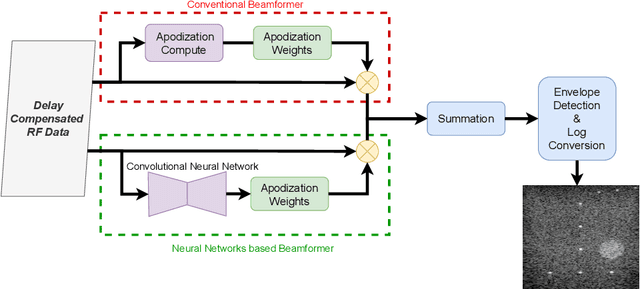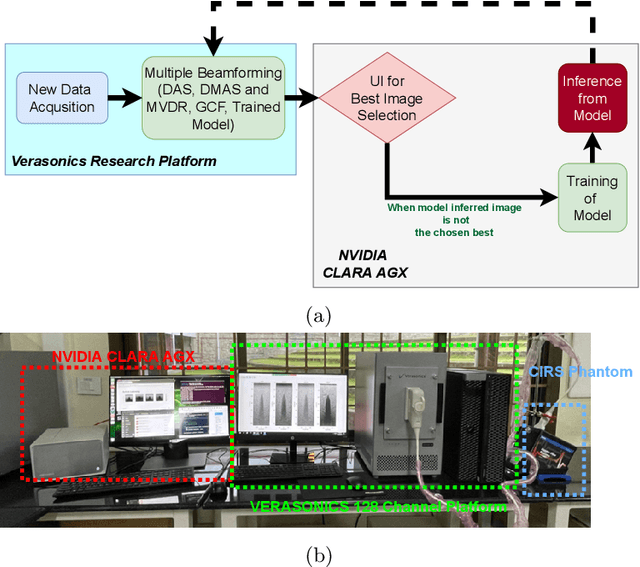A N Madhavanunni
Learning while Acquisition: Towards Active Learning Framework for Beamforming in Ultrasound Imaging
Jul 31, 2022



Abstract:In the recent past, there have been many efforts to accelerate adaptive beamforming for ultrasound (US) imaging using neural networks (NNs). However, most of these efforts are based on static models, i.e., they are trained to learn a single adaptive beamforming approach (e.g., minimum variance distortionless response (MVDR)) assuming that they result in the best image quality. Moreover, the training of such NNs is initiated only after acquiring a large set of data that consumes several gigabytes (GBs) of storage space. In this study, an active learning framework for beamforming is described for the first time in the context of NNs. The best quality image chosen by the user serves as the ground truth for the proposed technique, which trains the NN concurrently with data acqusition. On average, the active learning approach takes 0.5 seconds to complete a single iteration of training.
Patch Based Transformation for Minimum Variance Beamformer Image Approximation Using Delay and Sum Pipeline
Oct 19, 2021



Abstract:In the recent past, there have been several efforts in accelerating computationally heavy beamforming algorithms such as minimum variance distortionless response (MVDR) beamforming to achieve real-time performance comparable to the popular delay and sum (DAS) beamforming. This has been achieved using a variety of neural network architectures ranging from fully connected neural networks (FCNNs), convolutional neural networks (CNNs) and general adversarial networks (GANs). However most of these approaches are working with optimizations considering image level losses and hence require a significant amount of dataset to ensure that the process of beamforming is learned. In this work, a patch level U-Net based neural network is proposed, where the delay compensated radio frequency (RF) patch for a fixed region in space (e.g. 32x32) is transformed through a U-Net architecture and multiplied with DAS apodization weights and optimized for similarity with MVDR image of the patch. Instead of framing the beamforming problem as a regression problem to estimate the apodization weights, the proposed approach treats the non-linear transformation of the RF data space that can account for the data driven weight adaptation done by the MVDR approach in the parameters of the network. In this way, it is also observed that by restricting the input to a patch the model will learn the beamforming pipeline as an image non-linear transformation problem.
Microcontroller Based Load Monitoring System
Aug 11, 2021



Abstract:The demand for power has increased exponentially over the last century. One avenue through which today's energy problems can be addressed is through the reduction of energy usage in households. This has increased the emphasis on the need for accurate and economic methods of power measurement. The goal of providing such data is to optimize and reduce their power consumption. In view of this, the present manuscript focuses on the design and implementation of precise and reliable load monitoring system using PIC microcontroller chip (PIC16F877A). This involves an accurate sensing of voltage, current and power factor of the load. A clever utilization of in-built ADC and timers of the microcontroller reduces the design complexity of the system. The proposed system monitors the load continuously on a real time basis and displays the parameters such as voltage, current, power factor, active, reactive and apparent powers in an LCD module. The use of microcontroller reduces the cost and makes the device compact. The proposed system has been implemented and tested in the laboratory for single phase loads.
* Paper presented in International Conference on Control, Calibration and Testing (ICCCT '15), Feb 13-14, 2015, PSG College of Technology, Coimbatore, India
 Add to Chrome
Add to Chrome Add to Firefox
Add to Firefox Add to Edge
Add to Edge